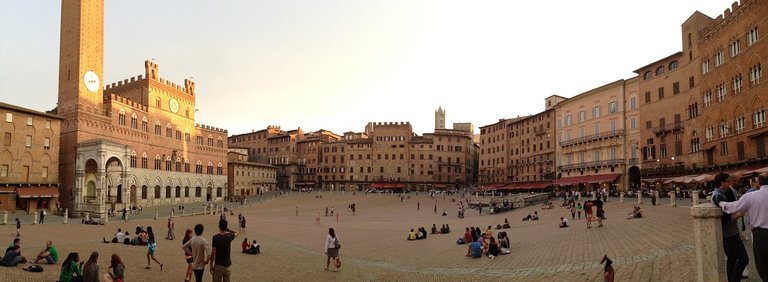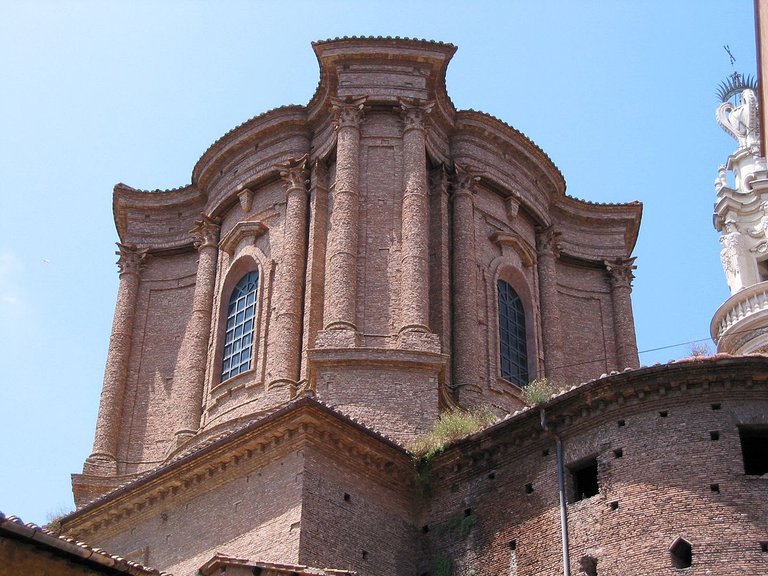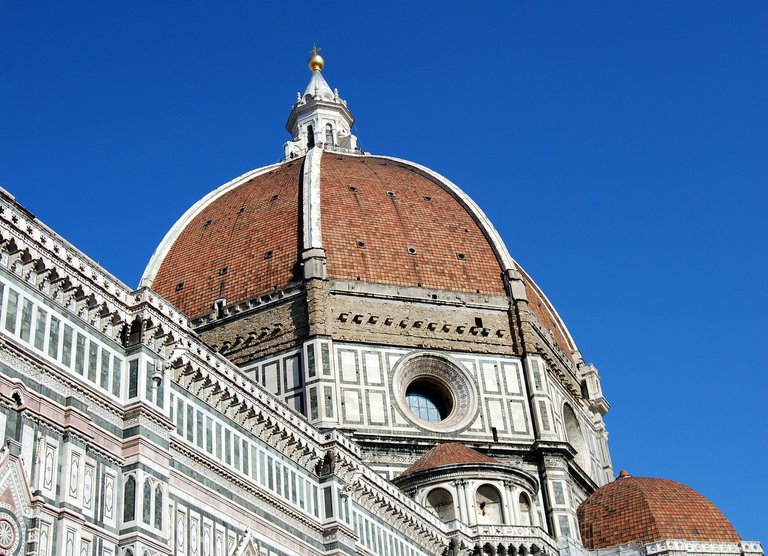
CCO Creative Commons Ziqqurat di Ur

Ciao amici di steemit,
pronti per la prossima tappa del nostro viaggio? Bene, ma prima di ripartire è doveroso fare un veloce sunto su quanto abbiamo visto: il laterizio ha origini antiche di migliaia di anni e il suo impiego è partito dalla città di Gerico fino a diffondersi praticamente in tutto il mondo. Abbiamo visto come avveniva la produzione dei laterizi e come, il mattone cotto in special modo, abbia trovato la sua massima espressione con il popolo romano. In fine, nell’ultimo articolo, ci siamo salutati accennando a come le tecniche del laterizio, accompagnate dall’impiego della pietra, si fecero strada anche nel periodo romanico e gotico.
E ora? Ecco, ora seguiremo il cammino e le evoluzioni del laterizio che lo hanno portato fino ai nostri giorni… come? andiamo a scoprirlo!
- Il laterizio nel Medioevo
Nel periodo medioevale, in cui si svilupparono, come sappiamo, l’architettura romanica e quella gotica, il laterizio trova largo consenso in Italia. Una città che vide il laterizio particolarmente protagonista nelle sue opere è Siena. Fra gli esempi più importanti ricordiamo la Torre del Mangia e Piazza del Campo, quest’ultima simbolo dell’uso del mattone anche come pavimentazione delle piazze che, come sappiamo, divennero uno spazio urbano di grande importanza in quel tempo.
Da un punto di vista tecnico-progettuale, una differenza sostanziale nell’impiego del laterizio tra la fase romanica e quella gotica è che nel primo caso il laterizio aveva un peso maggiore che nel secondo. Nel periodo romanico, infatti, a differenza del gotico, la muratura continua a svolgere un fondamentale ruolo statico in quanto il sistema di scarico della volta sul pilastro non è ancora sufficiente per garantire da solo la solidità dell’intera struttura. In quegli anni, infatti, la muratura continua, dovendo essere necessariamente presente, diviene, di conseguenza, un tratto distintivo dell’operato romanico.

CCO Creative Commons Piazza del Campo, Siena
- La fase rinascimentale
Il Rinascimento non fu un periodo molto fiorente per il laterizio rispetto agli anni precedenti. Tuttavia non si può non citare un’opera simbolo di questa transizione di epoche, ovvero la Cupola di Santa Maria del Fiore a Firenze, realizzata dal celebre Filippo Brunelleschi. In quest’opera, infatti, ritroviamo sia elementi gotici che elementi formali e tecnici tipici del periodo rinascimentale.
La cupola del Brunelleschi è forse il più alto esempio di innovazione strutturale di quegli anni. La grande intuizione, davanti alla difficoltà di realizzare armature lignee tali da reggere una così grande struttura della cupola per come era stata prevista, fu di crearne una che fosse in grado di autosostenersi in corso di costruzione.
Per fare questo l’architetto trasse ispirazione dal modo di fare muratura dei romani e i sistemi gotici a nervature. Diede così data una forma leggermente ogivale alla cupola, diversamente da quelle a calotta come erano in epoca romana. La tecnica fu di realizzare una doppia calotta, quella inferiore in muratura dai conci di pietra, e quella superiore in muratura di mattoni disposti a spina di pesce, ottenendo così un sistema che fosse autoportante.
Nonostante non avesse un seguito eclatante, nel Rinascimento non sono comunque mancate importanti testimonianze di impiego del laterizio nelle opere architettoniche, dove questo materiale si è reso elemento di spicco anche rispetto a molti altri. Per citare un esempio degno di nota in tal senso basti pensare al Palazzo Ducale di Urbino, dove il progettista, Luciano Laurana, fornisce la sua rielaborazione, in chiave rinascimentale, della tipologia edilizia del castello medievale.
Nell’ultimo periodo rinascimentale, quindi in epoca barocca, il laterizio rimane presente, anche se in forma più ridotta, nelle opere dei costruttori. Uno dei motivi è che viene riconsiderato anche per le sue notevoli qualità estetiche, vale a dire nella caratterizzazione delle facciate. Un esempio sicuramente degno di nota in tal senso è la Chiesa di Sant’Andrea delle Fratte a Roma, di Francesco Borromini.
Ma la storia del laterizio troverà presto una nuova svolta nella sua storia, e ciò avverrà in seguito ad un importante evento che segnò una grande svolta nel modo di fare architettura, ovvero la Rivoluzione Industriale. Naturalmente di questo ed altro ne parleremo, come già avete capito, nella prossima puntata… per così dire!
E insomma anche per oggi finisce qui. Non mi stancherò mai di dirvi grazie per avermi dedicato parte del vostro tempo prezioso che, come sempre, mi auguro per voi, dopo questa lettura, sia stato ben speso. Ok, ultima cosa, qualora ne abbiate voglia, ci si legge al prossimo post! Vi abbraccio tutti!
L'Ego dice: "Quando ogni cosa andrà a posto troverò la pace".
Lo Spirito dice: "Trova la pace e ogni cosa andrà a posto".

CCO Creative Commons Chiesa di Sant'Andrea delle Fratte, Roma

Hi friends of steemit,
ready for the next leg of our journey? Well, but before leaving, it is right to make a quick summary of what we have seen: the brick has ancient origins of thousands of years and its use started from the city of Jericho until it spread practically all over the world. We have seen how the production of bricks took place and how, the brick cooked in a special way, has found its maximum expression with the Roman people. Finally, in the last article, we said goodbye to how the techniques of bricks, accompanied by the use of stone, also made their way into the Romanesque and Gothic periods.
And now? Here, now we will follow the path and the evolution of the bricks that have brought him up to our days... how? Let's find out!
- Brick in the Middle Ages
In the medieval period, in which Romanesque and Gothic architecture developed, as we know, brick is widely accepted in Italy. A city that saw brick particularly protagonist in his works is Siena. Among the most important examples we mention the Torre del Mangia and Piazza del Campo, the latter symbol of the use of brick also as paving of the squares which, as we know, became an urban space of great importance at that time.
From a technical-planning point of view, a substantial difference in the use of bricks between the Romanesque and Gothic phases is that in the first case the brick had a greater weight than in the second. In the Romanesque period, in fact, unlike the Gothic, the masonry continues to play a fundamental static role as the vaulting system on the pillar is not yet sufficient to guarantee the solidity of the entire structure. In those years, in fact, the continuous masonry, having to be necessarily present, becomes, consequently, a distinctive feature of the Romanic work.
- The Renaissance phase
The Renaissance was not a very flourishing period for bricks compared to previous years. However, one can not fail to mention a work symbolizing this transition of times, namely the Dome of Santa Maria del Fiore in Florence, realized by the famous Filippo Brunelleschi. In this work, in fact, we find both Gothic elements and formal and technical elements typical of the Renaissance period.
Brunelleschi's dome is perhaps the highest example of structural innovation of those years. The great intuition, faced with the difficulty of creating wooden armatures such as to support such a large structure of the dome as was planned, was to create one that was able to self-sustain in the course of construction.
To do this, the architect was inspired by the Roman way of masonry and the gothic ribbed systems. He thus gave a slightly ogival shape to the dome, unlike the dome-shaped ones as they were in Roman times. The technique was to create a double cap, the lower one in masonry by the stone blocks, and the upper one in brick masonry arranged in a herringbone pattern, thus obtaining a self-supporting system.
Despite the fact that it did not have a striking following, in the Renaissance, important examples of the use of bricks in architectural works were not lacking, where this material became a prominent element also compared to many others. To cite an example worthy of note in this sense just think of the Palazzo Ducale of Urbino, where the designer, Luciano Laurana, provides his re-elaboration, in key Renaissance, of the building typology of the medieval castle.
In the last Renaissance period, then in the Baroque period, the brick remains present, even if in a smaller form, in the works of the builders. One of the reasons is that it is also reconsidered for its remarkable aesthetic qualities, that is to say in the characterization of the facades. An example certainly worthy of note in this sense is the Church of Sant'Andrea delle Fratte in Rome, by Francesco Borromini.
But the history of bricks will soon find a new turning point in its history, and this will happen after an important event that marked a major turning point in the way of making architecture, namely the Industrial Revolution. Of course this and more we will talk about, as you have already understood, in the next episode... so to speak!
And also for today it ends here. I will never tire of telling you thank you for dedicating part of your precious time which, as always, I hope for you, after this reading, has been well spent. Ok, last thing, if you feel like it, we read the next post! I embrace you all!
The ego says: "When everything goes right I will find peace"
The Spirit says: "Find peace and everything will fall into place"

CCO Creative Commons Cupola di Santa Maria del Fiore, Firenze
Useful! I subscribed, I hope for reciprocity. Offer for everyone! Checking subscriptions every other day